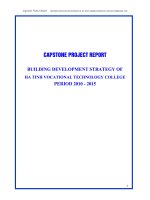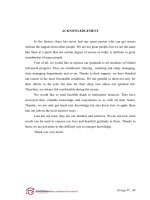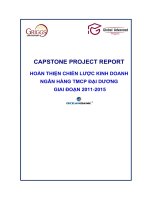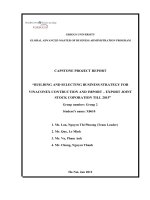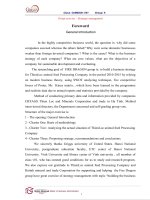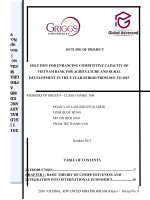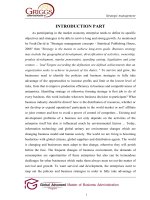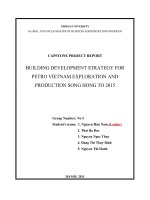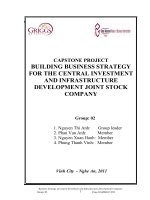Luận văn thạc sĩ quản trị kinh doanh quốc tế MBA (271)
Bạn đang xem bản rút gọn của tài liệu. Xem và tải ngay bản đầy đủ của tài liệu tại đây (740.87 KB, 81 trang )
CAPSTONE PROJECT REPORT
DEVELOPING BUSINESS STRATEGY FOR
TRANG AN SECURITIES JSC IN THE
PERIOD OF 2012 - 2017
Ngo Giao Hai
Duong Manh Hung
Nguyen Thi Thanh Huyen
Nguyen Minh Quang
Class: GaMBA.X0710
H A N O I
2 0 1 1
1
ACKNOWLEDGEMENT
First of all, the Group No.9 - GaMBA.X0710 would like to express our
sincere thanks for the Master of Business Administration Program, the Affiliate
Programs between Griggs University, USA and Center for Education Technology
and Career Development, Vietnam University Hanoi for organize MBA course in
Vietnam and facilitating our Capstone Project Report.
Secondly, we would like to express our sincere thanks to the Leaders and
staffs of Trang An Securities JSC - who have fully supported our team in providing
valuable input information for this Capstone Project Report.
Last but not least, let our thanks go to our families whose encouragement has
helped us complete the course without having any difficulties.
We have tried to complete the assignment in the best way using our best
knowledge and ability. However, the shortcomings are inevitable. We wish to
receive valuable comments from teachers and colleagues.
2
MỤC LỤC
3
LIST OF ABBREVIATIONS
APS: APEC securities joint stock company
AVC: Au Viet securities joint stock company
EFE: External Factor Evaluation
GDP: Gross Domestic Product
HRM: Human resource management
IFE: Internal Factor Evaluation
MIS : management information system
PEST: Political - Economics - Socio-culture - Technological
R&D: Research & develop
SWOT: Strengths, Weaknesses, Opportunities, Threats
SSC: Sao Viet securities joint stock company
QSPM: Quantitative Strategic Planning Matrix
TAS: Trang An securities joint stock company
JSC: Joint stock company
LIST OF TABLES
Table 1.1 Example of External Factor Evaluation
Table 1.2 Example of IFE matrix
Table 1.3: QSPM Model
Table 2.1: Some major contracts have been implemented by TAS
Table 2.2: The business result of Trang An securities JSC from 2008 to 2010
Table 2.3 Five-force analysis model
Table 2.4 SWOT analysis of competitors
Table 2.5: Compare some criteria in business TAS against rivals
Table 2.6: External Factor Evaluation matrix
Table 2.7: Evaluation of internal factors matrix
Table 2.8: SWOT matrix of TAS
Table 3.1: Some financial ratios
Table 3.2: The quantitative strategic planning matrix for optimal strategy
selection
4
LIST OF FIGURES
Figure:1.1: Process of strategic management
Figure 1.2: PEST model in macro-environment analysis
Figure 1.3 Five-force model of M. Porter
Figure: 2.1: Organizational Chart of TAS
Figure: 2.2: The GDP Growth of Vietnam from 2007 to present
and Forecast for 2012
Figure: 2.3: Inflation of Vietnam in period of 2000-2010
Figure: 2.4: Employee’s qualification of TAS
Figure:3.1: Market share of securities of brokers Vietnam 2010.
5
INTRODUCTION
I. The necessity and meaning of the research topic
The world economy has been in more stable phase after economic crisis and
is having significant development. Together with general development trend of the
world economy, Vietnam is gradually marking position in global economy. With the
open economy, demand on capital in regard to enterprises increases and become
diversified. Securities market, by means of a part of market. It is useful took to
solve demand on capital.
However, the ups and downs of market in 2010 and first half of 2011 have
made some securities companies recognize efficiency and adjust their trading activities.
As a new company, the Trang An Securities JSC has to face more competition not only
the domestic companies but also foreign firms with strong finance because the growing
number of competitors will reduce the TAS's market share
Coming from above problems, our groups realized the particularly important
role of building strategy for existence and development of a securities company.
Therefore, the group decided to select topic “Developing business strategy for
Trang An Securities Joint Stock Company in the period of 2012 - 2017" with
the desire to apply the our knowledge to contribute to the sustainable development
of the Company in the current situation.
II. Researching objectives
- To systematize basic knowledge and theory of strategic management and
strategy building.
- To initially approach to actual operations of securities company in
particular and Vietnam securities market in general and building a new business
strategy for company.
- To propose some solution strategies for the TAS during the period 2012 - 2017.
III. Subject and scope of the research
- Subject:
Analysis on the business environment of Trang An Securities Joint Stock
Company helps us build the business strategies for the Corporation during 2012-2017.
- Scope of the research:
6
Trading activities of Trang An Securities Joint Stock Company, Vietnam
securities market and some factors in currency market
IV. Research methodology
Primary data source used is the prospectus, annual report of the company, the
other companies in the industry and the data on public companies in the market.
From In addition to that, analysis and synthesis of data, logical thinking,
deductively etc. are also the methods used to complete the capstone project.
V. Structure of the research topic
Chapter 1: Literature review of strategy and strategic management
Chapter 2: The real situation of business activities of Trang An Securities
joint stock company
Chapter 3: Proposal of business strategies and implementation solution for
Trang An securities JSC in the period of 2012 – 2017.
7
CHAPTER 1
LITERATURE REVIEW OF STRATEGY AND STRATEGIC
MANAGEMENT
1.1. The concepts of development strategy
1.1.1 Concepts about strategy
From the past up to now, there are many views on the strategy. For example,
as is the view of Alain Threlart, ME Porter, G. Arlleret, D. Bizrell. But they all
revolve around the internal affairs such as: "Strategy is the art" or "strategy is a
special plan" or "the strategy is a plan, just as art"
According to the school of Harvard Business University (1965): “Strategy is
system of goals, targets stated under the form of sectors/business activities that the
company wants to, entry, size, position that the company wants to achieve and basic
policies as well as plans to implement predetermined targets”.
According Michael Porter: “Strategy is the creation of unique and valuable
position including differentiation, exchanged selection to focus on resources; from
that it brings advantages for organization”.
From above definition, we can see that strategy relates to long term and basic
goals of an enterprise. Nevertheless, building and selecting the strategy oriented
goals are not enough; strategy must be defined as matching to vision, mission of
organization and methods as well as means to reach those goals the most effectively.
If applicable, it promotes strengths, overcomes weaknesses, makes use of
opportunities and mitigates threats from external environment.
Thus, we can define strategy in general as following: “Strategy is a series of
complex activities to mobilize resources of organization and gain certain objective.”
1.1.2. The concept of strategic management:
- Strategic management is the process of researching, analyzing the external
and internal environment of a company in the current and future period; defining
the company’s objectives; planning, implementing and evaluating the strategy to
effectively utilize the resources and reach the desired goals.
- The process of strategic management:
8
Figure:1.1: Process of strategic management
1.1.3. The role of business strategy
The role of business strategy in enterprise is demonstrated through following issues:
- Business strategy helps enterprise define their orientation in each specific
period of time. It is guideline for all production and trading activities of enterprise.
- Business strategy helps enterprise catch and make use of opportunities,
promote strengths and have initiatives to overcome weaknesses, avoid or respond to
mitigate damages from external threats in competitive market.
- Business strategy has significant contribution to the effect of using
resources, promotes position of enterprise and ensures the continuous as well as
sustainable development.
- Business strategy creates solid foundation for enterprise to make decisions
in accordance with displacement of market. It also creates solid foundation for
research and deployment, development investment, human resource training, market
expansion and product development.
1.2. Process of building business strategy
1.2.1. Defining the business’s vision and mission
Vision: Strategic vision demonstrates the highest and the most general
desires and wishes that organization wants to achieve. We also consider vision as
9
routine of enterprise in which it shows the destination in the future and the way
enterprise will follow to reach that destination. Or in other words, strategic vision is
to draw a picture of destination together with reasons and means to do.
Defining and stating vision have particularly important role since it gathers
expectations of all members in enterprise and encourages them making efforts to
gain goals, career and noble ideas.
Mission: Mission or function is a statement having long term value in
objective and distinguishes this company to others. Such statements are also called
as business philosophy, business principles and belief of the company.
According to Drucker, the business mission statement gives answer to the
question “What is our business operation?” “What would we do and how would we
do to reach the vision statement?”
Core thinking
Core thinking defines long term features of an organization. It is consistent
definition over life cycle of product or market, technological breakthrough, ways of
administration and leaders. In fact, core thinking creates the most important and
stable contributions for success in a company with further vision.
Core thinking is basic and sustainable regulations, principles of organization.
Core values do not need to external defense. They have value and important within
organization. A company must determine value as a core that is dependent on
current environment, competitive environment and administration methods. In order
to recognize core value, we need to sort the honesty and define the central one.
1.2.2. Analyzing external environment
External environment includes factors, forces and regulations happening out
of enterprise. Enterprise cannot control them but they have significant influences to
efficiency and operation of enterprise.
Recognizing and assessing opportunities and threats from external
environment led enterprise define their mission and functions correctly and
obviously. Furthermore, enterprise can build strategies and reach long term target as
well as policies to reach annual targets.
External environment contains:
10
- Macro-environment or known as general environment;
- Sector environment or known as micro-environment or competitive
environment.
1.2.2.1. Analyzing macro-environment
Macro-environment is the environment covering activities and having direct
or indirect influences to all activities of company.
We can use PEST model to analyze macro-environment. The model includes:
- Political
- Economics
- Socio-culture
- Technological
Figure 1.2: PEST model in macro-environment analysis
Political environment
This is the factor which has affection to all industries in a country, factors
like: regulations and legal system can affect to every industries. When doing
business in administrative unit, enterprise has to follow its legal system.
- Stability: when study the political factor of enterprise we will take care of
stability of conflict political factors with legal systems. The country which has high
stability in political condition will give a better environment for enterprise to
11
expand its activities. On the contrary, instability in political conditions will give bad
affection to enterprise’s performance.
- Related law: investment law, enterprise law, labor law, anti monopoly and
dumping.
- Regulations: Government’s regulations also can create favorability or
challenges for enterprises. These regulations are: commercial regulations, industry
development regulations, tax, tariff, adjusting competition regulations, consumer
protection regulations, etc.
Legal environment
The administrative and legal environment in a country provides a framework
within which an organization operates. In some countries this environment is very
restrictive and has significant impact on all aspects of the organization; in other
countries the administrative/legal context is more permissive. Understanding the
administrative/legal environment is essential to determining if organizational
change can take place. The administrative context within which the organization
operates may be shaped by a unique combination of forces, including international,
governmental, nongovernmental policy, legislative, regulatory, and legal frame
staffs. An organization is affected by the policy or regulatory context that gave rise
to it. This includes specific laws and regulations that support or inhibit the
institution's development.
Economic factor
Enterprise needs to take care of economic factors both in short term and long
term. It also has to take care of intervention of Government into economy. In
general, enterprise will base on economic factor to decide which industry or section
to invest in.
- Economic situation: Any economy also has different cycles; in a specific
period of a cycle enterprise will have different decisions for its development.
- Factors which affect to economy: Interest rate, inflation.
- Economic regulators of Government: Basic salary law, Government’s
economic development strategy, favorable regulation for a specific industry,
increase tax or subsidiary, etc.
12
- Orientation of economy: Growth rate, GDP growth, GDP per capital.
Social-culture
Any country or region has its own specific characteristics. These
characteristics affect to consumer’s opinion here. Valuable traditions can make a
basic for a society and support for development of this society. So, tradition factors
are strictly protected, especially moral cultures. However, we cannot deny that there
is interfering in culture between counties. This interfering will change life style,
psychology and create development prospect for industry. Besides culture, social
factors and social characteristics also attract enterprise when making market
research. Social characteristics device society into many groups each group has
different income, psychology characteristics. Other social characters like:
- Average longevity, health situation
- Average income, income allocation
- Life style, life psychology, knowledge level
- Living conditions.
Natural environment
Natural condition is one of the most important factors in human life and it
also provides raw materials for many industries. Recently, natural condition is much
changed because of human destruction. It also can affect to development trend of
enterprises.
Technology
Recently, the whole world is still in technological revolution, list of model
technologies are implied and they are integrated into goods and services. Thirty
years ago, computer is only a tool used for calculation, now it is a tool with full
functions and can work as a person. Especially, in information technology section,
model communication helps us to shorten geographical distance.
1.2.2.2. Analyzing micro-environment
To analyze the micro-environment, organizations often use five-force model
of M. Porter – Father of competitive theories. Michael Porter provided a framework
that models an industry as being influenced by five forces. The strategic business
13
manager seeking to develop an edge over rival firms can use this model to better
understand the industry context in which the firm operates.
Potential entrants
It is not only incumbent rivals that pose a threat to firms in an industry; the
possibility that new firms may enter the industry also affects competition. In theory,
any firm should be able to enter and exit a market, and if free entry and exit exists,
then profits always should be nominal. In reality, however, industries possess
characteristics that protect the high profit levels of firms in the market and inhibit
additional rivals from entering the market.
Buyer power
The power of buyers is the impact that clients have on a producing industry.
In general, when buyer power is strong, the relationship to the producing industry is
near to what an economist terms a monopoly - a market in which there are many
suppliers and one buyer. Under such market conditions, the buyer sets the price. In
reality few pure monopolies exist, but frequently there is some asymmetry between
a producing industry and buyers.
Buyers are powerful if:
- Buyers are concentrated - there are a few buyers with significant market share
- Buyers purchase a significant proportion of output - distribution of
purchases or if the product is standardized
- Buyers possess a credible backward integration threat - can threaten to buy
producing firm or rival
Supplier power
A producing industry requires raw materials - labor, components, and other
supplies. This requirement leads to buyer-supplier relationships between the
industry and the firms that provide it the raw materials used to create products.
Suppliers, if powerful, can exert an influence on the producing industry, such as
selling raw materials at a high price to capture some of the industry's profits. The
following tables outline some factors that determine supplier power.
Suppliers are powerful if:
- Credible forward integration threat by suppliers
14
- Suppliers concentrated
- Significant cost to switch suppliers
- Clients Powerful
Threat of substitutes
In Porter's model, substitute products refer to products in other industries. To
the economist, a threat of substitutes exists when a product's demand is affected by
the price change of a substitute product. A product's price elasticity is affected by
substitute products - as more substitutes become available, the demand becomes
more elastic since clients have more alternatives. A close substitute product
constrains the ability of firms in an industry to raise prices. The competition
engendered by a Threat of Substitute comes from products outside the industry. The
price of aluminum beverage cans is constrained by the price of glass bottles, steel
cans, and plastic containers. These containers are substitutes, yet they are not rivals
in the aluminum can industry. To the manufacturer of automobile tires, tire retreads
are a substitute. Today, new tires are not so expensive that car owners give much
consideration to retreading old tires. But in the trucking industry new tires are
expensive and tires must be replaced often. In the truck tire market, retreading
remains a viable substitute industry. In the disposable diaper industry, cloth diapers
are a substitute and their prices constrain the price of disposables.
Competitive Rivalry
And last but not least, this describes the intensity of competition between
existing firms in an industry. Highly competitive industries generally earn low
returns because the cost of competition is high. A highly competitive market might
result from:
- Many players of about the same size, no dominant firm.
- Little differentiation between competitor’s products and services.
- A mature industry with very little growth.
- Companies can only grow by stealing clients away from competitors.
15
Figure 1.3 Five-force model of M. Porter
1.2.2.3. External Factor Evaluation EFE
External Factor Evaluation (EFE) matrix method is a strategic-management
tool often used for assessment of current business conditions. The EFE matrix is a
good tool to visualize and prioritize the opportunities and threats that a business is
facing. Five steps to create EFE matrix:
- Step 1: The first step is to gather a list of external factors. Divide factors
into two groups: opportunities and threats.
- Step 2: Assign a weight to each factor. The value of each weight should be
between 0 and 1 (or alternatively between 10 and 100 if you use the 10 to 100
scale). Zero means the factor is not important. One or hundred means that the factor
is the most influential and critical one. The total value of all weights together
should equal 1 or 100.
- Step 3: Assign a rating to each factor. Rating should be between 1 and 4.
Rating indicates how effective the firm’s current strategies respond to the factor. 1 =
the response is poor. 2 = the response is below average. 3 = above average. 4 =
superior. Weights are industry-specific. Ratings are company-specific.
- Step 4: Multiply each factor weight with its rating. This will calculate the
weighted score for each factor.
16
- Step 5: Add all weighted scores for each factor. This will calculate the total
weighted score for the company.
The sum of all weighted score is equal to the total weighted score; final value
of total weighted score should be between ranges from 1.0 (low) to 4.0(high). The
average weighted score for EFE matrix is 2.5 any company total weighted score fall
below 2.5 consider as weak. The company total weighted score higher than 2.5 is
consider as strong in position.
Table 1.1 Example of External Factor Evaluation
Total weighted score of 2.46 indicates that the business has slightly less than
average ability to respond to external factors.
1.2.3. Analyzing internal environment
The organization not only needs to be aware of the social, political and
economic environment in which it is operating, but also its internal environment ¾
its own strengths and weaknesses. For example, does a port have financial resources
such as cash reserves and access to cheap financing from the government? Does it
have human resources with the technological skill, motivation and productivity to
bring about a radical change of direction for the port if necessary? Does it have
17
facilities that are up-to-date technologically and/or with excess capacity? Does the
port have a commitment to on-going research and development?
The organization’s resources, its capabilities and competencies make up the
internal environment of the organization. The internal environment plays a crucial
role in the strategic management process of the organization. It is a direct reflection
of what the organization can do in the event of a business-related exigency. The
organization’s cores competencies help sustain it in the long run in the face of
competition.
1.2.3.1. Resource evaluation
Resources of an enterprise include human resource, asset and visible
resources. These are factors that play decisive roles of the success of the enterprise
in the market. In there, human resource is considered as the most important factor.
In each period, each resource has its own strength and weakness in comparison with
competitors. Managers have to evaluate precisely the organization’s resource in
order to compete with their competitors.
Human resource
Human resource is a term used to describe the individuals who comprise the
workforce of an organization, although it is also applied in labor economics to, for
example, business sectors or even whole nations. Human resource is also the name
of the function within an organization charged with the overall responsibility for
implementing strategies and policies relating to the management of individuals.
The objective of an organization's human resource management strategy is to
maximize the return on investment from the organization's human capital and minimize
financial risk. Human Resources seeks to achieve this by aligning the supply of skilled
and qualified individuals, and the capabilities of the current workforce, with the
ongoing and future business plans and requirements of the organization in order to
maximize return on investment and seeks to secure the future survival and success of
the entity. Human resource includes managers and followers
Assets
Assets of organization contain capitals, factories, equipments, materials and
business information…Each organization has its own features of assets, including
18
strengths and weaknesses in comparison with competitors. The asset evaluation is
really useful for any company. This is a basic for them to know exactly how strong
they really are and whether they have to borrow assets from outside.
Visible resources
Besides above resources, every enterprise has another resource which cannot
be seen by eyes and is called visible resources. This resource might originate from
efforts of all members of the organization in the operation process. It is expressed in
many different types that only senior managers can realize and understand the
importance of this resource. They are vision, mission, value and many more.
To sum up, resources of an organization are really plentiful. Depending on
specific conditions of each organization, they can evaluate their resource in order to
determine their strength and weakness.
1.2.3.2. Evaluation of functional departments
Depending on the company’s allocation, each functional department has a
specific function and mission. Typical departments in an organization are:
Marketing, Human Resource, Finance, R&D, production…
Marketing department:
The term marketing has changed and evolved over a period of time, today
marketing is based around providing continual benefits to the customer, these
benefits will be provided and a transactional exchange will take place.
The
Chartered Institute of Marketing defines marketing as 'The management process
responsible for identifying, anticipating and satisfying customer requirements
profitably'. If we look at this definition in more detail Marketing is a management
responsibility and should not be solely left to junior members of staff. Marketing
requires co-ordination, planning, implementation of campaigns and a competent
manager(s) with the appropriate skills to ensure success.
Marketing activities include:
- Market research: This aims to study marketing environment to determine
opportunities, goals, and market position and consumer insight as well.
- Marketing strategy planning: The area of marketing planning involves
forging a plan for a firm's marketing activities. A marketing plan can also pertain to
a specific product, as well as to an organization's overall marketing strategy.
19
Generally speaking, an organization’s marketing planning process is derived
from its overall business strategy. Thus, when top management is devising the firm's
strategic direction or mission, the intended marketing activities are incorporated
into this plan. There are several levels of marketing objectives within an
organization. The senior management of a firm would formulate a general business
strategy for a firm. However, this general business strategy would be interpreted and
implemented in different contexts throughout the firm.
HR department:
Human resource management (HRM) is the strategic and coherent approach
to the management of an organization's most valued assets - the people working
there who individually and collectively contribute to the achievement of the
objectives of the business. The terms "human resource management" and "human
resources" (HR) have largely replaced the term "personnel management" as a
description of the processes involved in managing people in organizations. In
simple sense, HRM means employing people, developing their capacities, utilizing,
maintaining and compensating their services in tune with the job and organizational
requirement.
An HRM strategy pertains to the means as to how to implement the specific
functions of HRM. An organization’s HR function may possess recruitment and
selection policies, disciplinary procedures, reward/recognition policies, an HR plan,
or learning and development policies; however all of these functional areas of HRM
need to be aligned and correlated, in order to correspond with the overall business
strategy. An HRM strategy thus is an overall plan, concerning the implementation of
specific HRM functional areas.
Financial & accounting department
This part of the organization relates to resource allocations in each period of
strategy implementation. Its function determines the effect of strategy
implementation and then organization’s development. Role of accounts department
in a corporation is:
- Financial accounting: financial and fixed asset reporting; payroll; accounts
payable
20
- Accounting function: maintain the general and subsidiary ledgers; process
and record all revenues and prepare general purpose financial statements in
compliance with IFRSs
- Accounting oversight and guidance to other internal departments to ensure
the gap, legal requirements, policies and procedures - all consistently applied to
maintain the integrity of the financial records.
- Management accounting - budgeting, performance evaluation, cost
management, asset management
R&D department
Research and development, often called R&D, is a phrase that means
different things in different applications. In the world of business, research and
development is the phase in a product's life that might be considered the product's
'conception'. That is, basic science must exist to support the product's viability, and
if the science is lacking, it must be discovered - this is considered the research
phase. If the science exists, then turning it into a useful product is the development
phase.
Research and development is an investment in a company's future companies that do not spend sufficiently in R&D are often said to be 'eating the
seed corn'; that is, when their current product lines become outdated and overtaken
by their competitors, they will not have viable successors in the pipeline. So how
much is reasonable to spend on research and development? That is highly
dependent both on the technology area and how fast the market is moving. Two
percent of company revenue, not profit, might be enough in a fairly sedate market,
but to keep up in rapidly changing markets, companies should expect to spend
fifteen percent or more in research and development just to keep up with the rest of
the pack.
Management information system of the enterprise
A management information system (MIS) is a subset of the overall internal
controls of a business covering the application of people, documents, technologies,
and procedures by management accountants to solve business problems such as
costing a product, service or a business-wide strategy. Management information
21
systems are distinct from regular information systems in that they are used to
analyze other information systems applied in operational activities in the
organization. This system plays an important role in management. It helps the
organization to control and manage all activities and keep a contact with their
clients.
1.2.3.2. Internal Factor Evaluation IFE
Internal Factor Evaluation (IFE) matrix is a strategic management tool
for auditing or evaluating major strengths and weaknesses in functional areas of a
business. IFE matrix also provides a basis for identifying and evaluating
relationships among those areas. The Internal Factor Evaluation matrix or short IFE
matrix is used in strategy formulation. This matrix is built through 5 following
steps:
- Step 1: Conduct internal audit and identify both strengths and weaknesses
in all your business areas. It is suggested you identify 10 to 20 internal factors, but
the more you can provide for the IFE matrix, the better.
- Step 2: Having identified strengths and weaknesses, the core of the IFE
matrix, assign a weight that ranges from 0.00 to 1.00 to each factor. The weight
assigned to a given factor indicates the relative importance of the factor. Zero means
not important. One indicates very important.
- Step 3: Assign a 1 to X rating to each factor. Your rating scale can be per
your preference. Practitioners usually use rating on the scale from 1 to 4.
Rating captures whether the factor represents a major weakness (rating = 1), a
minor weakness (rating = 2), a minor strength (rating = 3), or a major strength
(rating = 4). If you use the rating scale 1 to 4, then strengths must receive a 4 or 3
rating and weaknesses must receive a 1 or 2 rating.
- Step 4: Multiply each factor's weight by its rating. This will give a weighted
score for each factor.
- Step 5: The last step in constructing the IFE matrix is to sum the weighted
scores for each factor. This provides the total weighted score
Total weighted scores well below 2.5 point to internally weak business.
Scores significantly above 2.5 indicate a strong internal position.
22
Table 1.2 Example of IFE matrix
1.2.4. Strategy formulation
1.2.4.1. Strategy formulation process
Strategy formulation is the process of determining appropriate courses of
action for achieving organizational objectives and thereby accomplishing
organizational purpose. The strategy the company formulates should reflect
environmental analysis, lead to fulfillment of organizational vision, and result in
reaching organizational objectives. Special tools the company can use to assist it in
formulating strategies include critical question analysis, SWOT analysis, business
portfolio analysis, Porter's model for industry analysis, and resource-based model.
These five strategy development tools are related but distinct. The company should
use the tool or combination of tools that is most appropriate for the company and
business environment.
1.2.4.2. SWOT Matrix
SWOT matrix is a strategic planning method used to evaluate the Strengths,
Weaknesses, Opportunities, and Threats involved in a project or in a business
venture. It involves specifying the objective of the business venture or project and
identifying the internal and external factors that are favorable and unfavorable to
23
achieving that objective. The technique is credited to Albert Humphrey, who led a
convention at Stanford University in the 1960s and 1970s using data from Fortune
500 companies. SWOT matrix usually gives out four basic strategies: (1) SO
(strength – opportunity): strategies which base on company’s strengths to deploy
market’s opportunities. (2) WO (weaknesses - opportunities): strategies which base
on ability of getting through company’s weaknesses to deploy market’s
opportunities. (3) ST (strengths - threats): company’s strategies to avoid market’s
threats. (4) WT (weaknesses- threats): company’s strategies to get through
weaknesses and avoid market’s threats.
SWOT
MATRIX
Opportunities
(O)
Threats (T)
-
Strengths(S)
SO
Using strong points to deploy
market’s opportunities
Weaknesses (W)
WO
Getting through weakness by
deploying opportunities
ST
Using strong points to avoid
threats
WT
Minimize weaknesses to avoid
threats
To implement SWOT analysis we usually make some following question:
Strengths: Two factors contribute to strengths: ability and resources
available.
Ability is evaluated on 3 counts:
- Versatility: your ability to adapt to an ever changing environment.
- Growth: your ability to maintain a continuing growth.
- Markets: your ability to penetrate or create new markets.
The strength of resources has three dimensions:
- Availability: your ability to obtain the resources needed.
- Quality: the quality and up-to-datedness of the resources employed.
24
- Allocation: your ability to distribute resources both effectively and
efficiently.
Weaknesses: A company’s weaknesses are determined through failures,
defeats, losses and inability to match up with the dynamic situation and rapid
change. The weaknesses may be rooted in lack of managerial skills, insufficient
quality, technological backwardness, inadequate systems or processes, slow
deliveries, or shortage of resources.
Opportunities: Opportunities are abundant. You must develop a formula
which will help you define what comes within the ambit of an opportunity to focus
on those areas and pursue those opportunities where effectiveness is possible. The
formula must define product/service, target market, capabilities required and
resources to be employed, returns expected and the level of risk allowed.
Threats:
External
threats
arise
from
political,
economic,
social,
technological forces. Technological developments may make your offerings
obsolete. Market changes may result from the changes in the customer needs,
competitors' moves, or demographic shifts. The political situation determines
government policy and taxation structure.
1.2.4.3. The Competitive Profile Matrix (CPM)
The Competitive Profile Matrix is set up through 5 steps:
- Step 1: Create a list 10 about 10 main factors that have significant influence
to the competitiveness of the company in the same industry.
- Step 2: The weight range from 0.0 (minimum importance) to 1.0 (more
important factor) to the company. The weight assigned to each factor depends on
how important the specific factor for the company’s success. The total of the
weighted score is 1.0.
- Step 3: Assign 1 to 4 rating to each critical success factor to indicate how
effectively the firm’s current strategies respond to the factor. 4 - Response is
extremely good, 3- response is above average, 2- response is average, 1 - response
is poor.
25
